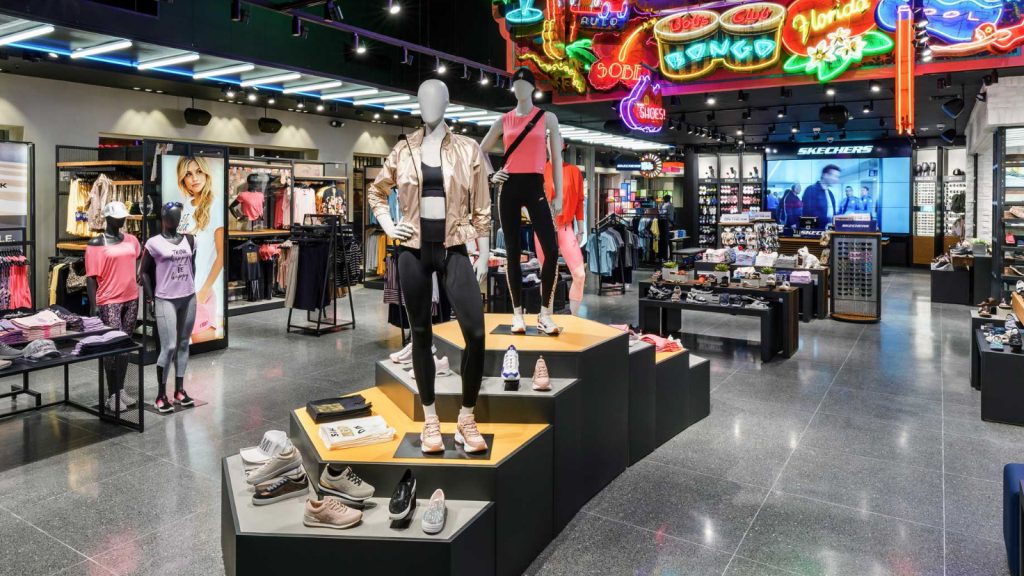In a meeting at Morgan Stanley’s Global Sporting Goods Day, John Vandemore, Skechers’ CFO, said the company is well-positioned to gain market share in the challenging economic climate and benefitted from major footwear brands reducing their wholesale distribution to emphasize direct-to-consumer growth.
Asked whether Skechers would be a “potential shelf space winner” since Nike and Adidas reduced its wholesale footprint in favor of going direct, Vandemore said that Skechers could not take advantage of the DTC channel shifts in 2021 due to inventory constraints caused by supply chain challenges.
“Now we have very healthy dialogues with many customers, customers whom we already service, about how we can continue to augment their offerings of Skechers,” said Vandemore. “And, I think, you’re going to continue to see us ply forward and take as much of that shelf space as we feel we’re capable of successfully assuming.”
Vandemore does not expect Skechers can attain “every ounce of shelf space” but noted that the company provides “exceptional breadth” compared to larger players, including Nike and Adidas, to offer solutions for retail chains.
Vandemore said a competitive advantage Skechers has is its diverse product range from traditional athletic sport and performance to clogs, sandals, work footwear, and casual silhouettes.
The CFO said, “Our ability to tuck in and fill in on opportunities, as well as bring new categories to many of those customers, is unparalleled.”
Vandemore added that while the company can “certainly appreciate and understand what the other brands are trying to do” in their direct push, Skechers continues to see wholesale as a major growth channel. He said, “Our goal is to get Skechers to as many points of distribution as satisfies consumer needs. And so, we will continue to support that wholesale channel as long as it’s in a way that supports our brand. And I think in that, we see an opportunity to continue to grow our footprint and in addition our productivity.”
Asked if Skechers tends to benefit from economic slowdowns, including the current period as consumers gravitate towards value, Vandemore said, “First and foremost, we’re not trying to be the least expensive solution in the marketplace. That’s not really what we do. But what we try to do is very capably balance what we’re charging with what we’re delivering. So it’s really about the overall value picture. What I think that then lends us the opportunity for is greater durability of demand in economic recessionary environments. What we’ve seen traditionally is that even in past instances where consumer discretionary spend has been under duress, Skechers has continued to grow.”
He added, “Is that trade down? Is that simply preserved capacity at the consumer level? I think it’s probably a little bit of both. But what we know is that what we offer is appreciated at the consumer level and their ability to continue to afford that is maintained even in economically-challenging environments.”
Overall, Vandemore said Skechers stood out for four key characteristics—”products that are stylish, that are good quality, that are reasonably priced, and that are insanely comfortable. So style, comfort, quality at a reasonable price.”
Vandemore said Skechers sees itself as a complement to other footwear solutions delivered in the marketplace. He added, “We don’t expect in every instance to solve everybody’s footwear problems or needs or wants. But the ones that we can solve, we think we offer the best value for the money out there in the market today.”
Looking ahead, Vandemore said that Skechers is noticing “conservatism relative to ‘23” and “some nervousness materializing in orders” amid speculation about a coming recession, but he said Skechers hasn’t yet felt a consumer spending pullback. He said, “If you look at the consumer today, what you generally are seeing is healthy spending patterns. You’re seeing a good back to school. You’re seeing good sell through”.
He noted that the inventory challenges faced by retailers are the result of supply chain issues. The significantly-elevated inventory levels seen by many are partly to largely due to year-ago inventories being depleted by supply chain constraints and inventories are more balanced compared to the more-normalized, pre-pandemic 2019 quarter.
“It’s really important to try to get an apples-to-apples view,” said Vandemore. “We think that when you do look at it at kind of a comparable view on timing and expected deliveries, there’s still more conservatism than the current environment would suggest is necessary. I think we’ll have to see how the holidays go and how consumer demand goes but if things remain steady, I would actually anticipate that some of that conservatism, some of that nervousness will actually have been misplaced.”
For now, Vandemore said Skechers is also adjusting the timing of orders in light of the cautionary forward buying patterns., Ge said, “Everybody’s concerned about the environment, concerned about where the consumer goes, concerned about recession…and that’s definitely leading to some more restrained booking activity at this point in time.”
Photo courtesy Skechers
















